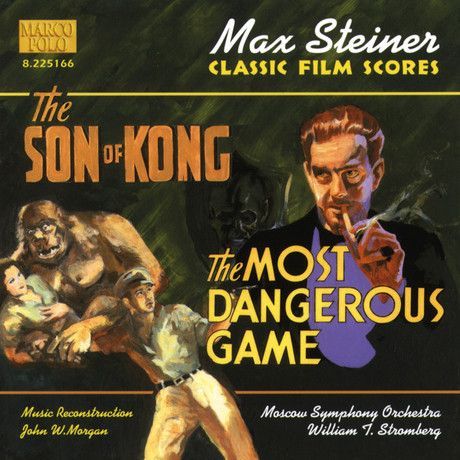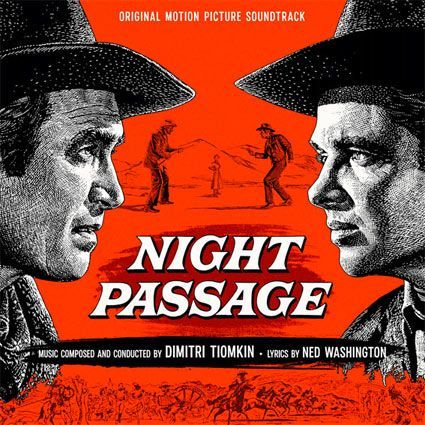The Son of Kong / The Most Dangerous Game

Label: Marco Polo
Catalogue No: 8.225166
Release Date: Feb-2001
Total Duration: 77:13
UPN: 6-3694-35166-2-1
William Stromberg conducts the Moscow Symphony Orchestra
As a movie, SON OF KONG was a pale shadow of its forbearer, a hastily put-together sequel to the greatest fantasy adventure of the 1930s, and an endearing classic to this day. SON was not without its charm, however, as it strove to be more comically cute than its predecessor, although in so doing eschewed the brilliant adventure of KING KONG for its more cornball comedy. THE MOST DANGEROUS GAME, which preceded KING KONG by a year, was filmed by the same crew on the same sets. In fact, all three RKO films form a kind of creative trilogy, as pointed out by Ron Fortier in his explanatory notes accompanying this remarkable new release. Fortier also remarks that “… the charming score for SON OF KONG, when set apart from the film, arguably makes for a far more cohesive and pleasurable listening experience than even that for KING KONG, for all its titanic, ground- shaking verve.”
I’m not quite sure I share that opinion, but as a follow-up to KONG, which remains the first great musical score of the talking era, SON is constructed around very similar thematic material, and appropriately so. You’ll recognize many motifs from the Skull Island sequences in KING KONG, although there are plenty of new motifs woven into this new fabric as well. In the forty five and a half minutes reconstructed with his usual grace and faithfulness by John W. Morgan, conductor Stromberg takes the Moscow Symphony through a wild assortment of crescendos, mysteriosos and melodic interludes – not to mention plenty of quotations included by Steiner for comic moments (such as the oft-discussed musical reference to Yiddish “Klezmermusik” that Steiner launches into when the young giant ape suddenly stares at the camera and shrugs his shoulders in classic “Oy Vey” fashion).
Steiner composed his own source material for the SON score – “Runaway Blues” is a really neat bluesy melody (“Russian Waltz,” in GAME, is a piano concerto treated orchestrally in the action scenes). By so doing, Steiner was able to use his “Casablanca-technique” of crafting his action material around the source music by using his own material, rather than that of other composers (as with CASABLANCA). Steiner’s music is varied and rich, and superbly played with an intimate sense of scope and largeness by the Moscow Symphony. In terms of thematic interplay, diversity, and strength, the vigorous SON score becomes, indeed, the equal of that for his old man, and makes for a fine listen now almost 70 years later.
THE MOST DANGEROUS GAME, which predated both KONG score, begins with a slow, menacing mysterioso built around echoes of a main two-note repeated motif. The music builds into a pretty violin melody that will recur later. “The Wreck” sustains a wonderfully ominous build up that grows into a dynamic crescendo, followed by a tender, sympathetic interlude. The cue segues into the next one (as most of the short cues do, a nice touch that adds a satisfying musical continuity to the playback), a dark and threatening mood is employed as the shipwreck survivors survey their island salvation. Steiner effectively suggests that it may not be all the salvation they hope.
Much of GAME is built around a remarkable piano concerto, the “Russian Waltz” (GAME’s source material) – the megalomaniacal Dr. Zaroff is a pianist and the music is first heard from his hands. This motif becomes the balancing element for the score – the island is Zaroff’s playground – upon which he hunts the hapless survivors of ships he has drawn to his rocky shores. The lyric of the main title hinted at in its melody, and the chase music of the film’s second half will draw repeatedly from it, reminding us who is in charge here. Only at the end does Zaroff’s theme – playing off of that of the hero’s and heroine’s music as they struggle against him in a final fight – brighten as they escape from his clutches. But even as the score ends, it is Zaroff’s theme that remains. The music is a little more subdued and straightforward than SON OF KONG, but it’s a perfect match, both in terms of cinematic continuity, and in style and scope of the music.
The CD includes a hefty 36-page booklet full of crisp, black and white photos and a perceptive analysis of the music by Bill Whitaker, Fortier’s introductory analysis of the music, an introduction by Ray Harryhausen (who owes his whole career to KING KONG and who regrets never having been able to get Steiner to score one of his movies!) and significant arranger’s notes by John Morgan. Marco Polo wraps it all in their usual fine package (the cover painting by Scott MacQueen and cover design by Ron Hoares is especially evocative). The vigor of the music and the rarity of these scores make this recording one of the label’s finest and most welcome.



